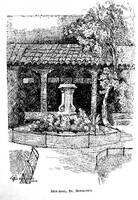Another much-frequented but much smaller churchyard is that of St. Katharine Coleman. Suddenly, in a corner of crowded Fenchurch Street, comes this retired shade. The church, with its old high pews, and tiny graveyard, devoid of monuments, is a peaceful oasis. These surprises in the densest parts of the City are very refreshing, and they are too numerous to mention each individually. Most of them now are neatly kept, though some look dreary enough. None of them recall the neglect of half a century ago. St. Olave's, Hart Street, in Seething Lane, is perhaps among the most gloomy. It is the church Pepys speaks of so often as "our owne church," and was one of the churches that escaped the Fire. The archway with the skulls over it, leads from Seething Lane to the dismal-looking churchyard. Nothing is done to alter or brighten this place of many memories. One shudders to think of what it must have been like when Pepys crossed it for the first time after the Great Plague, when he went to the memorial service for King Charles I., on 30th January 1666. No wonder he says it "frighted me indeed to go through the church more than I thought it could have done, to see so many graves lie so high upon the churchyard, where people have been buried of the Plague. I was much troubled about it, and do not think to go through it again a good while." The parish registers show that no less than 326 were interred in this very small place, during the previous six months, so Pepys' feelings were well justified. The old church has a special interest to lovers of gardens, as in it is the tomb of William Turner, the author of the first English Herbal.
[St. Katharine Coleman was demolished in 1926]

